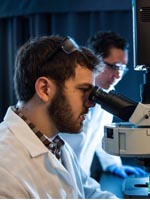Seminars 2015-2016
The Seminar Series begin at 11:30am unless otherwise specified. Food will be served before the seminars. Financial support for the seminars was kindly provided by the Rackham Graduate School.

|
April 24, 2017 Digital Microfluidics for Chemistry, Biology, and Medicine 11:00- 1:00 | Johnson Room, 3rd floor LECDr. Aaron Wheeler Digital microfluidics is a fluid-handling technique in which droplets are manipulated by electrostatic forces on an array of electrodes coated with a hydrophobic insulator. In contrast to the more common format of microchannel-based fluidics, digital microfluidics is uniquely well-suited for carrying out sequential chemical processing steps in multiple samples in parallel. This talk will cover my group's recent work applying digital microfluidics to problems in chemistry, biology, and medicine, including organic synthesis and integrated analysis, integrated cell culture and evaluation, and point-of-care diagnostics in resource-limited settings These examples and others suggest that digital microfluidics is emerging as a useful new tool for sample preparation and analysis, and may eventually play an important role in the next generation of laboratory methods, across many different disciplines.
|

|
April 3, 2017 Segregating reagents in a one-step micro-well multiplex immunoassay 11:45-12:45 | FXB Room 1008Cameron Yamanishi High-throughput protein assays have gained popularity, due to their relatively low sample, cost, and labor requirements. These multiplex assays measure multiple proteins within a single well. Many of these techniques use spatial location of antibodies within a well to distinguish targets. However, this approach is susceptible to cross-reactions between reagents, particularly at higher number of targets. Aqueous two-phase systems (ATPS) have been used by the Takayama Lab to confine assay reagents within microdroplets inside wells to reduce the cross-reaction problem. In this work, the ATPS reagents are pre-spotted and dried for a one-step immunoassay. Although flow in dehydrating droplets has been well described, there has been little examination of rehydration flow. To track flow, this work uses astigmatic microscopy, a technique developed for 3D deconvolution by separating x- and y-focal planes to identify z-positions of particles. Although analysis is ongoing, preliminary results indicate that the composition of the dehydrated phase influences the flow pattern, while the continuous phase has a stronger effect on the intensity of the flow pattern. With a better understanding of the rehydration dynamics, assay time may be reduced.
|

|
March 20, 2017 sNETs: Serendipity at the Interface of Microfluidics and Immunology 11:45-12:45 | FXB Room 1008Priyan Weerappuli Traditionally, academic researchers have largely refrained from formally sharing the results of ‘failed’ experiments, often referred to as negative-data. If this practice is considered in conjunction with the tendency of researchers to store knowledge within discipline-specific silos, one may appreciate the serendipitous origin of this project. The work presented during this talk is drawn from the efforts of an interdisciplinary team of researchers who have worked in coordination to develop and characterize a synthetic DNA-histone complex capable of recapitulating properties of neutrophil extracellular traps (NETs).
|

|
March 6, 2017 Application of a graphene oxide chip for circulating tumor cell isolation and transcriptome analysis in prostate cancer 11:45-12:45 | FXB Room 1008Molly Kozminsky Though commonly diagnosed by prostate specific antigen (PSA) testing, prostate cancer is the subject of conflicting opinions regarding overdiagnosis in the face of a disease that can take radically different trajectories. There remains a need for a test that better informs the severity of the disease. Those cells in the process of metastasizing, or circulating tumor cells (CTCs), may provide answers, but their study is complicated by their rarity surrounded by billions of blood cells. A highly sensitive graphene oxide (GO) based microfluidic device was used for antibody based CTC isolation. CTCs were isolated from 43 whole blood samples from prostate cancer patients using two parallel GO Chips, one for enumeration and one for RNA extraction. Immunofluorescence staining detected CTCs in all 43 samples (range: 3-166 cells/mL), with examples of both single CTCs and clusters of CTCs ranging from two to ten in number. RNA was extracted from 38 samples to determine the relative expression levels of 96 genes of interest for comparison between different patient groups of relevance. The results of this study show the potential of CTCs to answer questions that might help guide therapeutic management, allowing a more strategic approach to prostate cancer care.
|

|
February 20, 2017 Single Cell Analyses Enabling Discovery in Cancer Biology 11:45-12:45 | FXB Room 1008Dr. Yu-Chih Chen Due to the genomic and epigenetic instability of cancer cells, tumors are highly heterogeneous and thus difficult to treat. As such, ideal assays should be high-throughput and provide single-cell resolution, enlightening individual cell properties rather than the average behavior of the bulk tumor. Here, we have developed microfluidic platforms meeting these requirements to investigate critical stages of cancer metastasis, which accounts for 90% of cancer mortality. These single-cell platforms provide numerous advantages over traditional methods including: (1) ability to monitor and track individual cells, (2) control of various micro-environments on-chip for emulation of bio-processes, (3) accommodation of high-throughput screening, (4) capability to handle small number of cells, and (5) automation of data collection and analysis. In addition to characterizing cell behaviors on-chip, we sorted cells based on their behaviors and performed whole transcriptome next generation sequencing (NGS) to pinpoint undiscovered key genes and pathways in cancer development and metastasis. Combining unbiased cell analysis and data mining, we envision this data-driven approach will change the paradigm of bio-discovery.
|

|
January 25, 2017 Interstitial fluid flow and the cellular tumor microenvironment: effects on invasion and therapeutic outcomes 11:00-12:00 | NCRC B520 Room 1122Dr. Jennifer Munson Glioblastoma, the deadliest form of brain cancer, is defined by the invasive nature of its cells. Invasion in the brain follows distinctive routes that correlate with interstitial and bulk flow pathways. In brain cancer, increased interstitial fluid flow develops due to the increase in interstitial pressure in the tumor bulk interfacing with the relatively normal pressure of the surrounding brain tissue. This differential leads to fluid transport specifically across the invasive edge of the tumor where cells are prone to both interact with the surrounding brain tissue and to evade localized, transport-limited therapies. In vitro, we have found that interstitial flow can enhance invasion of brain cancer cells using both cell lines and patient-derived glioma stem cells in tissue-engineered models of the brain-tumor interface. These effects are mediated simultaneously by both chemotactic and mechanotransduction mechanisms. In vivo, we have seen interstitial flow both correlate and increase invasion of implanted cancer cells through the brain. By conducting in vivo measurements of interstitial flow, using MRI techniques, we have seen correlations between interstitial fluid flow and patterns of glial activation, extracellular matrix deposition, and receptor activation in tumor-associated brain along these invasive pathways. These findings further implicate interstitial fluid flow as a driver of tissue morphology and indicate multiple mechanisms through which fluid flow can mediate cellular invasion and therapeutic outcomes.
|

|
December 13, 2016 Automating Epigenomics: Progress toward a Microfluidic Chromatin ImmunoCapture Device 11:45-12:45pm | GG Brown 2147Dr. Ryan Bailey Insights into epigenetics and chromatin dynamics have profoundly affected our understanding of biological processes by providing a comprehensive insight beyond what could be ascertained by considering information from genetic or gene expression studies alone. Chromatin immunoprecipitation (ChIP), the method of choice for investigating interactions between histones, non-histone proteins, and DNA in this context, is relatively complicated compared to tools used to identify and analyze somatic mutations, and has yet to be standardized for clinical use. We are developing a droplet microfluidic approach to carry out quantitative chromatin analysis, beginning with chromatin fragmentation and proceeding to solid-state immunocapture. Droplet microfluidics have several key advantages that make them amenable to rapid, versatile, and robust ChIP analysis and this presentation will describe work-in-progress towards these goals, including on-chip chromatin digestion and new microfluidic constructs that are enabling for the robust automation of multi-step biomolecular sample processing steps.
|

|
November 22, 2016 Integrating Sample Preparation and Sensing for Bio/Chemical Analytics and Diagnostics 11:45-12:45pm | GG Brown 2147Dr. Ian White One of the continuing promises of microsystems is the capability to move diagnostics away from the central lab and into field-based applications, including point-of-care diagnostics. However, to be used away from the central lab – especially in point-of-care diagnostics – the approach must truly be sample-to-answer, i.e., no manual intervention steps and no precise manipulations. Two technologies will be presented that have followed this approach to sensing and diagnostics. First, we will review the capabilities of inkjet-fabricated paper surface enhanced Raman spectroscopy (P-SERS) devices as chemical and biological sensors. The fabrication of paper-based fluidic SERS devices using low-cost commercial inkjet printers will be introduced. We will then review results for chemical detection with paper SERS devices, including the use of the paper substrates as swabs and dipsticks for sample collection and detection, as well as chromatography SERS for sample preparation and detection in applications removed from the central lab. Examples include the detection of melamine in infant formula and therapeutic drug monitoring at the point-of-care. Second, we will review a streamlined approach to nucleic-acid-based molecular diagnostics by amplifying DNA directly from the sample preparation material (direct PCR). Microparticles functionalized with the cationic biopolymer chitosan are utilized to lyse cells, bind DNA during removal of PCR inhibitors, and transfer the DNA to the PCR reaction. Amplification of human genomic DNA from whole blood with unprecedented simplicity will be presented.
|

|
November 08, 2016 Microfluidics for Mapping Epigenomes in the World of Precision Medicine 11:45-12:45pm | GG Brown 2147Dr. Chang Lu Precision medicine requires comprehensive analysis of the molecular drivers of a disease for individual patients and use of the information to devise therapeutic procedures. In the post-genome era, such analysis benefits tremendously from decreasing cost of next-generation sequencing and improvement in big data processing. However, critical technical barrier still exists for establishing genome-wide profiles using tiny amounts of samples extracted from patients and lab animals. In this seminar, I will discuss our efforts on using microfluidics as a versatile platform for profiling epigenomes based on a low number of cells in the context of precision medicine. The epigenome turns on and off genes in a highly dynamic fashion during normal development and diseases, forming another layer of regulation on top of gene sequence. We developed MOWChIP-seq to profile histone modifications using as few as 100 cells (2015 Nature Methods). More recently, we developed microfluidic assays to probe genome-wide DNA methylation. I will discuss our studies of cell-type specific epigenomic landscapes in the context of stem cell differentiation and brain functions using these tools. These new technologies will generate insights into disease processes and help create personalized treatment strategies.
|

|
October 25, 2016 Scaling and Automation of a High-Throughput Single-Cell-Derived Tumor Sphere Assay Chip 11:45-12:45pm | GG Brown 2147Yu-Heng Cheng Recent research suggests that cancer stem-like cells (CSCs) are the key subpopulation for tumor relapse and metastasis. Due to the cancer plasticity in surface antigen and enzymatic activity markers, functional tumorsphere assays are promising alternatives for CSC identification. In this work, we present the scaling and automation of high-throughput single-cell-derived tumor sphere assay chips, facilitating the tracking of up to ~10,000 cells on a chip with ~76.5% capture rate. To analyze thousands of single-cells with a variety of fluorescent intensities, a highly adaptable analysis program was developed for cell/sphere counting and size measurement. Using Pluronic® F108 (Poly(ethylene glycol)-block-poly(propylene glycol)-block-poly(ethylene glycol)) coating on Polydimethylsiloxane (PDMS), a suspension culture environment was created to test a controversial hypothesis: whether larger or smaller cells are more stem-like defined by the capability to form single-cell-derived spheres. Different cell lines showed different correlations between sphere formation rate and initial cell size, suggesting heterogeneity in pathway regulation among breast cancer cell lines. More interestingly, by monitoring hundreds of spheres, we identified heterogeneity in sphere growth dynamics, indicating the cellular heterogeneity even within CSCs. These preliminary results highlight the power of unprecedented high-throughput and automation in CSC studies.
|

|
October 11, 2016 Development of a novel cell-free platform for investigating the roles of neutrophil extracellular trap components in vitro 11:30-12:30pm | GG Brown 2147Cameron Louttit Termed the “double-edged swords of innate immunity” by Kaplan and Radic, neutrophil extracellular traps (NETs) are vital contributors to innate defenses but also participate in the pathogeneses of many diseases including systemic lupus erythematosus, rheumatoid arthritis, thrombosis, and cancer. Despite their vast clinical impact, NETs have proven difficult to study in high quantity and isolation due to both their fragility and the challenges of working with the neutrophils from which they are derived. These difficulties prevent researchers from understanding the roles of NETs and their constituent components, effectively rendering an entire branch of potential therapeutic strategies unattainable. This talk will focus on the development of a novel platform, rooted in the principles of aqueous two-phase systems, which enables us to ask new questions about NETs and the individual and combinatorial roles of their components.
|

|
September 27, 2016 An additive manufacturing approach to printing cells and microbeads within digitally addressed hydrogel matrices 11:30-12:30pm | Boulevard Room at Pierpont CommonsDr. C. Ryan Oliver Rapid prototyping of new hydrogel-based structures, including tissue scaffolds, organs-on-chip, and hybrid bioelectronic materials, requires flexible fabrication techniques capable of positioning multiple materials in 2D and 3D with micro-scale resolution and accuracy. Despite their impressive accomplishments, current methods for micro-scale additive manufacturing are limited to a single material (e.g. projection micro stereolithography) or require sequential or parallel use of multiple nozzles to deposit different materials. An alternative approach would be to digitally place discrete building blocks, e.g. microbeads or cells within a 3D matrix such as a hydrogel. This strategy would enable control over both the global and local properties of the fabricated part.
In this talk I will be discussing progress in the development of a new micro-scale additive manufacturing process (first realized while in the Mechanosynthesis group), enabling local and regional control over the placement of microscale objects in a 3D matrix. This method uses feedback from a high-speed machine vision system to guide the placement of microscale objects using a digital light processing device (DLP). I will also discuss the potential applications of this approach and challenges including clumping, clogging and digital errors.
These results show promise to enable on-demand additive manufacture of soft structures with digital three-dimensional placement of discrete building blocks.
|

|
September 13, 2016 Can microfluidic flow-based diagnostics personalize therapy in sickle cell disease?: A vision for the future 11:30-12:30pm | LBME AtriumDr. Patrick Charles Hines This is an historic moment in sickle cell discovery with the largest pipeline of promising SCD-specific drugs in preclinical and clinical trials in the history of the disease. Despite this, there is no clinical standard for assessing erythrocyte adhesion. Dr. Hines has used flow adhesion models to understand the adhesive properties of sickle erythrocytes in a simulated blood flow environment, and has worked to standardize this process for clinical testing. He recently founded Functional Fluidics, a startup company who has deployed a standardized microfluidic flow-based test into the preclinical and clinical research market. Dr. Hines will discuss advances in microfluidic flow-based blood function testing, the role these tests are play in preclinical drug validation, and the potential for applications in sickle cell clinical trials and ultimately clinical therapy.
|
